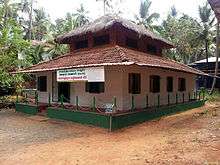Alavi Thangal

| Sayyid Mouladaveela Mamburam Thangal | |||||
|---|---|---|---|---|---|
| Successor | Fazal Pookoya Thangal | ||||
| Born |
1166 Hijra Tarim, Kathiri State of Seiyun in Hadhramaut (modern Yemen) | ||||
| Died |
AD1845 Mambaram, Malabar, Madras State, British India | ||||
| Burial | Mambaram, Kerala, India | ||||
| Spouse |
Fatima | ||||
| Issue |
Sharifa Alaviya | ||||
| |||||
| House | Alavi | ||||
| Father | Sheikh Muhammed bin Sahl | ||||
| Religion | Islam | ||||
| Part of a series on |
| Islam |
|---|
 |
|
Related topics |
|
Alavi Mouladaveel (Arabic: سيّد علوي مولو الدويلة, Malayalam: സയ്യിദ് അലവി മൌലദവീല) (Tarim, Kathiri State of Seiyun in Hadhramaut (modern Yemen) 1752 - Mambaram, Malabar, Madras State, British India 1845) was a Yemeni Islamic scholar who settled at Mambaram in Kerala, India. His tomb, located at Mambaram, is now considered as one of greatest pilgrimage centres in southern India.[1][2][3] His son was Sayyid Fadl, also known as Fazal Pookoya Thangal.
Early life
Alavi Mouladaveel, the 30th grandson of Imam Husain, is hailing from Tarim of Hadhramaut. Members of this family got due consideration and were spiritual leaders. Sayyid Alavi was born to Sheikh Muhammed bin Sahl and Fathima in Hijra 1166. The parents left him in his early childhood and he was later grown up under the aunt (mother’s sister).[4]
Root of family
The lineage of Sayyid reaches holy prohet Muhammed. The following is his lineage[5]
- Sayyid Hassan Jifri
- Sayyid Shikh
- Sayyid Hassan
- Sayyid Alawi
- Sayyid Muhammed
- Sayyid Aboobacker
- Sayyid Abdul rahmean
- Sayyid Abadullah
- Sayyid Alawi
- Sayyid Aboobacker Al Jifri
- Sayyid Muhammed
- Sayyid Ahmed
- Sayyid Ahmed
- Sayydi Muhammed Al Faqeehul Mukdam
- Sayyid Ali
- Sayyid Muhammed Sabithul Mirabath
- Sayyyid Qualia Qasam
- Sayyid Muhammed
- Sayyid Alawi
- Sayyid Ubaidullah
- Sayyid Abdul Muhajir
- Sayyid Eesannaqeeb
- Sayyid Muhammed
- Sayyid Aliyyul Uraidi
- Sayyid Jarar Swadique
- Sayyid Muhammed Baqir
- Sayyid Zainul Abideen
- Imam Hussain
- Fathima Bivi
- Prophet Muhammadصلّى الله عليه السلّم
Education
He learnt by hearted the holy Quran in his early age of eight and possessed very fluency in Arabic language. His primary education was at the home town of Tareem from the school of sheikh.
In Malabar
His uncles, Hasan Jifri and Sheikh Jifri left to Malabar for the sake of propagation and influenced the natives of Malabar in very short period. Sayyid left to the coast of Malabar by ship from Sheharmukalla in his 17th age and reached in Calicut in hijra 1183 Ramadan 19. Later he settled in Mambaram and then so called Mamburam Thangal as well as Arabi Thangal. He became famous after prediction he had done during the early period of his settlement in Malabar.
Family life
Hasan Jifri, the family member of Sayyid Alavi, reached Malabar coast for propagation and fetched high popularity by his idle life. During his last time he said to Jamaludin Maqdoomi, then Quazi of Tirur, to marry his daughter to a youth that will come from Tarim. after the arrival of Sayyid Alavi, Jamaludin Maqdoomi married Fatima to this charismatic young prodigy hailing from Tarim after attracting in his personal qualification in Hijra 1183 Rabeel Avval. He stayed for a short period in his bride house but later shifted to permanent maliyakal house nearby Mamburam Juma Masjid. he had two daughter in this spouse, Sharifa Alaviya and Sharifa, later known as Kunhbivi. After the demise of Fatima he tied the knot with Fatima, the daughter of Sayyid Aboobacker Madani of Kovl Kandi Ambarkand of Koyilandy. He had sole son in this relation, Fazal Pookoya Thangal . In his 50th age he married Ayisha from Tanur and had two daughters, Swaliha and Fathima. His three spouse left this mortal world in his lifetime and he then married Swalaiha, from Sile of Indonesia.
In the spiritual world
Sayyid Alavi Mauladaveela followed the Bualawi Thareeqath, sub branch of Quadriya Thareeqath, related to the saint Abdul Quadir Aljeelani . He was recognised as Qutub Zaman (leader of valiyes, saint in century) by the Sunni world. He suggested spiritual treatment for his disciple as well as infidel that consulted him. He was being consulted for personal issues as well as social and was considered as greatest leader in the horizon of spiritual world. There was a huge crowd follower for this prodigy. He provided elas (chain consisted of some divine things).
Sayyid Alavi in the path of struggle
When the Mappilas attacked with inspiration of Alavi Mauladhavila, British government became frightened. he provided military practice with gun and sophisticated weapons ensuring a new generation capable for war. The following are major mophla outrages under the inspiration of Sayyid Alavi
- Eranad riot in November 20, 1836
- Eranad riot in April 15, 1837
- Paruthan riot in April 19
Demise
Sayyid Alavi Mouladaveela became ill in Hijra 1259 following to an injury in his leg. Many doctors and Vaidyars suggested medicine but he left this mortal world in Sunday Hijra 1260 Muharram 7 (AD1845) and was buried in Mambaram.
References
- ↑ http://keralapilgrimcenters.com/sayyid-alavi-thangal-mouladdavila-mampuram/
- ↑ "Ashraf NlknWebsite". Retrieved 2012-11-07.
- ↑ Proceedings of the Indian History Congress Indian History Congress 2006 - Page 483 "Murtaza Sahib, who presided over the Khilafat Conference on the same day, took the chair at this conference also.51 A Committee was formed under Sayyid Alavi Thangal as life-time president,"
- ↑ "History Website". Retrieved 2012-11-07.
- ↑ http://groups.yahoo.com/group/NewsToday/message/6974?var=1